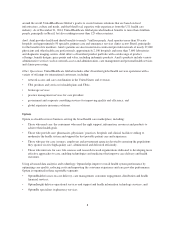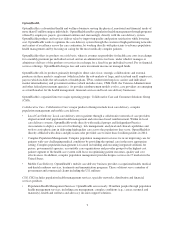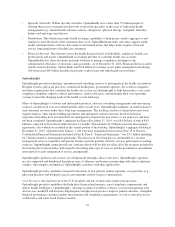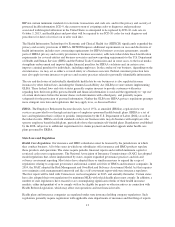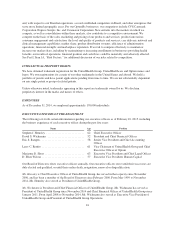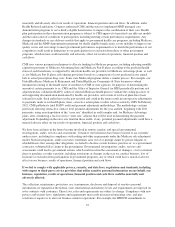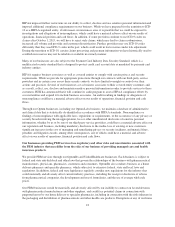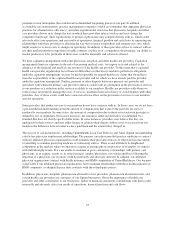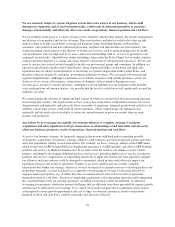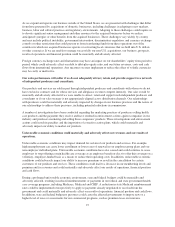United Healthcare 2014 Annual Report Download - page 20
Download and view the complete annual report
Please find page 20 of the 2014 United Healthcare annual report below. You can navigate through the pages in the report by either clicking on the pages listed below, or by using the keyword search tool below to find specific information within the annual report.statements involve risks and uncertainties that may cause our actual results to differ materially from the
expectations expressed or implied in the forward-looking statements. Any forward-looking statement speaks only
as of the date of this report and, except as required by law; we undertake no obligation to update any forward-
looking statement to reflect events or circumstances, including unanticipated events, after the date of this report.
The following discussion contains cautionary statements regarding our business that investors and others should
consider. We do not undertake to address in future filings or communications regarding our business or results of
operations how any of these factors may have caused our results to differ from discussions or information
contained in previous filings or communications. In addition, any of the matters discussed below may have
affected past, as well as current, forward-looking statements about future results. Any or all forward-looking
statements in this Annual Report on Form 10-K and in any other public filings or statements we make may turn
out to be wrong. They can be affected by inaccurate assumptions we might make or by known or unknown risks
and uncertainties. Many factors discussed below will be important in determining our future results. By their
nature, forward-looking statements are not guarantees of future performance or results and are subject to risks,
uncertainties and assumptions that are difficult to predict or quantify.
If we fail to estimate, price for and manage our medical costs in an effective manner, the profitability of
our risk-based products and services could decline and could materially and adversely affect our results of
operations, financial position and cash flows.
Through our risk-based benefit products, we assume the risk of both medical and administrative costs for our
customers in return for monthly premiums. Premium revenues from risk-based benefits products comprise nearly
90% of our total consolidated revenues. We generally use approximately 80% to 85% of our premium revenues
to pay the costs of health care services delivered to these customers. The profitability of our products depends in
large part on our ability to predict, price for, and effectively manage medical costs. In this regard, Health Reform
Legislation established minimum MLRs for certain health plans and authorized HHS to maintain an annual price
increase review process for commercial health plans, which could make it more difficult for us to increase the
prices of our products. In addition, our OptumHealth Local Care Delivery business negotiates capitation
arrangements with commercial third-party payers. Under the typical capitation arrangement, the health care
provider receives a fixed percentage of a third-party payer’s premiums to cover all or a defined portion of the
medical costs provided to the capitated member. If we fail to predict accurately, price for or manage the costs of
providing care to our capitated members, our results of operations could be materially and adversely affected.
We manage medical costs through underwriting criteria, product design, negotiation of favorable provider
contracts and care management programs. Total medical costs are affected by the number of individual services
rendered, the cost of each service and the type of service rendered. Our premium revenue on commercial policies
is typically at a fixed monthly rate per individual served for a 12-month period and is generally priced one to four
months before the contract commences. Our revenue on Medicare policies is based on bids submitted in June the
year before the contract year. Although we base the premiums we charge and our Medicare bids on our estimates
of future medical costs over the fixed contract period, many factors may cause actual costs to exceed those
estimated and reflected in premiums or bids. These factors may include medical cost inflation, increased use of
services, increased cost of individual services, natural catastrophes or other large-scale medical emergencies,
epidemics, the introduction of new or costly drugs, treatments and technology, new mandated benefits (such as
the expansion of essential benefits coverage) or other regulatory changes and insured population characteristics.
Relatively small differences between predicted and actual medical costs or utilization rates as a percentage of
revenues can result in significant changes in our financial results. For example, if our 2014 medical costs for
commercial insured products were 1% higher, without proportionally higher revenues from such products, our
annual net earnings for 2014 would have been reduced by approximately $190 million, excluding any offsetting
impact from premium rebates due to minimum MLRs.
In addition, the financial results we report for any particular period include estimates of costs that have been
incurred for which claims are still outstanding. These estimates involve an extensive degree of judgment. If these
estimates prove too low, our results of operations could be materially and adversely affected.
18


